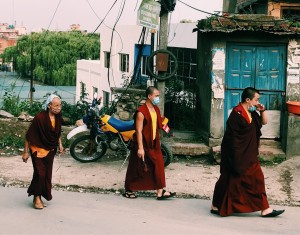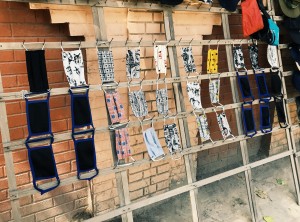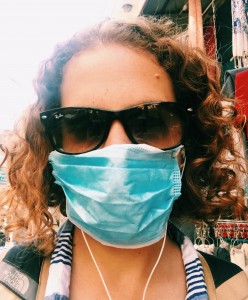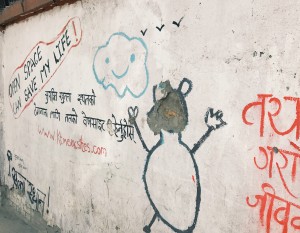When I first arrived to Kathmandu, Bijaya’s email read “welcome to our dusty capital city”. At that moment I didn’t quite get what he was referring to – yes, the minute you land in Nepal you can tell that the air quality is not the best. Too many motorcycles, old trucks and streets without proper pavement means constant dust in the air. But that is not very different from the reality of many cities in the world, and therefore I didn’t quite understand why dust was the ultimate trademark of Kathmandu.
But as days went by, reality kicked in. I noticed how I started coughing more, and how it was hard for me to take a full breath. Sometimes it was even difficult for me to climb the stairs of the temple I had to go through on my way to work and every time I cleaned my face at the end of the day, the tissue came out completely black. If that is what I had in my face, imagine my lungs!
After 3 weeks the inevitable thing happened…my throat and lungs decided to give up and I ended up in the clinic with a severe allergic reaction to dust. Apparently it is something very common here: the doctors gave me some antihistaminic for the allergy and an inhaled treatment to help open my respiratory system. And of course, told me to ALWAYS wear a mask…something I’ve not considered even though most people in the city do use one.
After taking the medicine for two days I felt fine again. I still cough a little bit and feel like my lungs need a break from all the dust, but I’m OK. However, this episode got me thinking about the long-term consequences of bad air quality. I’ve always lived in places where, even though pollution is a real problem, is not as bad as to consider it as an impediment for every day activities. In fact, whenever my friends from China and India tell me about how bad air quality is in their countries, and how that is actually something they consider when thinking about what to do once they are done with their PhD, I don’t actually understand what they refer to. But after three weeks in Nepal, I got it. Air pollution transforms the way you live. It gives you eye irritation (real bad for those of us who wear contact lenses), dries your skin, closes your respiratory system and leaves you with less energy.
By doing a quick Google search, I found out that just over the last year, the number of patients with respiratory problems increased by 20 percent in the Kathmandu area (hey, at least I’m not alone!). The responsible? Dust pollution. The consequences? Lung disorders, allergic rhinitis, allergic asthma, bronchial asthma, coughing, wheezing and shortness of breath. I even read one doctor saying “Kathmandu Valley is not a livable place for those who are allergic to dust” – I hope I can prove them wrong!
Of course bad air quality affects the kids and the elderly more than any other group. And suddenly I realized why CONCERN’s legal name is CONCERN for children and environment. Children need clean air to be able to study, play and grow properly. I wish that in the upcoming years something is done with this issue that affects millions of people around the globe and has negative irreversible consequences for our future.
Posted By Cynthia Boruchowicz (Nepal)
Posted Jun 23rd, 2017






8 Comments
Iain Guest
June 27, 2017
Poor Cynthia! It either seems to be dust or mud in Kathmandu. Hope you get over the allergy soon. By the way, your photos are excellent. Also, very nicely written!
Cynthia Boruchowicz (Nepal)
June 30, 2017
Thanks! I hope so too!!
Bri
June 28, 2017
I’m glad everything turned out ok, Cynthia! I agree that it’s very interesting and crucial to think about the intersection of children’s rights and the environment. I wonder if poor air quality is a factor in the school attendance of the students you work with. Thank you for sharing both the ups and the downs with us!
Cynthia Boruchowicz (Nepal)
June 30, 2017
Thanks Bri! Definitely, many of the kids who still work in the factories say they are constantly exposed to dust…which of course is not good for their academic performance